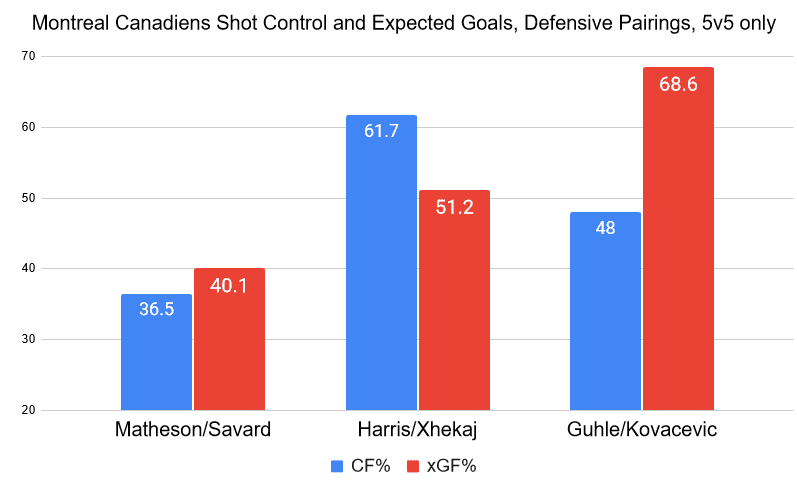Canadiens Analysis
The Canadiens Defensive Situation Brings Good & Bad News

The Montreal Canadiens are not playing until Saturday when they’ll face the struggling Washington Capitals at the Bell Centre.
That allows us to take a look at some of the numbers the defensive pairings have produced in the first three games of the season.
It’s very early, which means the sample sizes are not ideal, but the results are still very telling.
The Canadiens have used three pairings to start the season. Mike Matheson is paired with David Savard on the first pairing. The second and third pairings vary, with Kaiden Guhle and Johnathan Kovacevic sometimes receiving more shifts than Jordan Harris and Arber Xhekaj, but if we’re basing it on ice time, both pairings have alternated between second and third pairing duties.
Defensive Pairings Results
Montreal has actually done a pretty good job controlling the pace of play at 5v5 this season.
The Habs are above 50 percent in shot control (CF%), and they’ve jumped all the way to 53.3 percent in expected goals (xGF%). This is notable because last season they controlled just 45.5 percent of the shots and 43.6 percent of the expected goals.
That means that while the special teams have been a complete disaster in the early parts of the 2023-24 season, the Habs have looked very good during even-strength play.
To drive the point home, we can simply look at their goal share. In the first three games of the season, the Montreal Canadiens have outscored their opponents 8-1 during 5v5 play.
As for the actual results for the defencemen, they point to a significant issue when it comes to the usage of the various pairings.
Statistically speaking, the Matheson-Savard duo has struggled.
They haven’t just struggled a little, either.
The Matheson and Savard pairing is well below the team’s average in two crucial metrics. They’ve only managed to control 36.5 percent of the shots and 40.1 percent of the expected goals.
Contrast their results with what the other pairings have done, and the juxtaposition is rather eye-opening.
When Harris and Xhekaj are on the ice, the Habs control well over 60 percent of the shots and have an advantage in expected goals. The team doesn’t control as many shots when the Guhle and Kovacevic pairing is playing, but thanks to their ability to control high-danger scoring chances, the Canadiens are expected to control almost 70 percent of the goals during their shifts.

The Kovacevic Factor
It’s not surprising that Kovacevic once again features on the pairing that has the highest xGF% on the team. It was the case last year when he played with Harris, and it’s likely to continue regardless of his usage.
He’s not flashy, and most don’t appreciate what he brings to the table, but there’s no denying that Kovacevic produces great results.
“I think Kovy is Kovy, no matter what, no matter who he plays with,” explained head coach Martin St-Louis. “He understands what he is, he knows what he has to improve on. He’s a very intelligent young man. He’s very honest, too. But he knows what he’s good at. I don’t think it really matters who we pair him with.
“He defends very well. He’s got a good stick defensively. He has the vision to see the game developing in front of him. He’s a pretty intelligent player on the ice.”
St-Louis hits on the most important aspect of Kovacevic’s game: his intelligence. The cerebral defenceman can adapt to the situation with the greatest ease because he processes information at an elevated level compared to his counterparts.
It’s also encouraging to see his numbers on this pairing since Guhle struggled a lot from a statistical standpoint last season. Part of it was because he was used on the top pairing as a rookie, but the most significant factor was that he was paired with Savard, who, historically speaking, acts as a statistical anchor on most of his defensive pairings.
A nice controlled entry by Guhle gives Tanner Pearson all the time he needs to snipe a goal.
2-0 #Habs
Love to see it for Pearson. He was pumped. pic.twitter.com/a3bWTRyaeT— Marc Dumont (@MarcPDumont) October 15, 2023
Guhle had great numbers alongside any other partner last season, which is why many of us expected him to flourish this season. The injury will be a setback, but thankfully, he’s not expected to miss a significant portion of the regular season.
Xhekaj and Harris
The success of this pairing is not unexpected either. Xhekaj had very encouraging numbers last year until his fight card became too busy and his shoulder was no longer at full health.
The two players complement each other rather well, with Harris doing the yeoman’s work in the defensive and neutral zones, while Xhekaj performs well in the offensive zone.
“I feel like Jordo (Harris) is really good goal line to far blue line,” said St-Louis. “I feel Jacko (Xhekaj) is more of a threat blue-line in. They both have to improve their games, but when you put them together, they’re covering each other’s weaknesses. And I like it.”
Matheson and Savard
I don’t want to be too harsh toward Savard, because he’s being used in an overwhelming situation.
The Canadiens seem dead set on using him on the top pairing, but that’s never been where he excels. Savard still has value playing in a depth role, but it’s a little confusing as to why Stephane Robidas insists on giving him heavy minutes against the opposing team’s best players.
It’s a bad strategy, full stop.
Matheson has shown he can handle those difficult minutes, and until he was paired with Savard this season, his numbers have been exemplary in Montreal.
That leads me to believe that the issue is Savard’s usage, and that’s something that the player doesn’t actually control. It’s up to the coaches to take notice of the weakness in the defensive pairings.
Coaches tend to trust veteran defencemen, and in some cases, it works, but for the Montreal Canadiens, it’s quite clear that the younger players on the blue line are capable of producing better numbers than what we’ve seen from the Savard.
All Montreal Canadiens statistics are 5v5 unless otherwise noted, via NaturalStatTrick.










